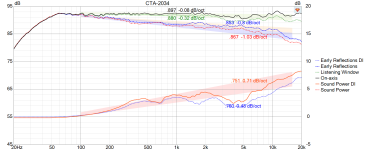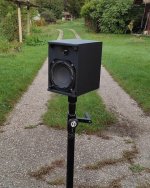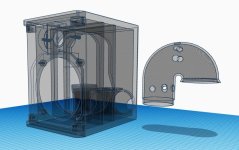Hey everyone, I’ve been sketching out a 3-way speaker build and wanted to get your thoughts on mixing pro audio components with hi-fi ones in a single design.
Here's what I’m thinking:
Appreciate any insight or real-world experience anyone can share—thanks!
Here's what I’m thinking:
- Highs: Compression driver + waveguide (pro audio style)
- Mids: SICA 8 Fe 2.5cp (8" pro midrange)
- Lows: Instead of a typical pro sub, I’m considering the Peerless by Tymphany XXLS-P830845 (12" Nomex Cone Subwoofer, 8 Ohm), which is more of a hi-fi driver with a lower sensitivity (~87dB).
- +3dB from doubling the driver count
- +3dB from halving the impedance (going from 8Ω to 4Ω load)
Appreciate any insight or real-world experience anyone can share—thanks!
Yes, FS is around 27hz. I was looking at an existing design that was built to be a “power hifi speaker” capable of playing very loud while maintaining its composure. I noticed they opted to use a pro driver sub for the low frequencies and while it appears to get the job done it doesn’t look to play as low as it should for being a 15in driver.
This is all just theoretical which is why I’m asking. I just didn’t know if something like this is feasible or I’m just chasing my tail. I didn’t know if the speaker could theoretically be redesigned to a utilize hifi woofer instead.
That particular woofer was just being used as an example.
Here is the design I am speaking of.
https://www.donhighend.de/?page_id=7616
This is all just theoretical which is why I’m asking. I just didn’t know if something like this is feasible or I’m just chasing my tail. I didn’t know if the speaker could theoretically be redesigned to a utilize hifi woofer instead.
That particular woofer was just being used as an example.
Here is the design I am speaking of.
https://www.donhighend.de/?page_id=7616
Of course you can find a way to make it work. You might even use different amplification for the woofer so you can adjust it's gain independently.
I’m aware of utilizing separate amplification, but I was curious about implementing it utilizing passive crossover 3-way ( one input )
I didn’t know if the techniques I originally mentioned was enough to actually raise the SPL to match the other drivers while benefiting from the lower FS.
I didn’t know if the techniques I originally mentioned was enough to actually raise the SPL to match the other drivers while benefiting from the lower FS.
I don't think your math is correct. The mid will need a lot of padding, and resistors will get hot.
Last edited:
OP wants to destroy his hearing. His previous threads state a desire for over 100dB for sustained periods. The mid he is asking about will be padded about 10dB, and likely crossed at 300hz. I see nothing but problems. If you want to waste your time on this, go right ahead.
My system will play to levels approaching 117dBSpl at the listening position on some material, but this does not mean I ever push it that far in normal use. My average listening SPLs would be in the 70 - 80dB range. The woofers, mid and HF drivers and horns are based on (or are) pro gear.
My one comment is that subwoofer drivers may not have good performance in the upper bass and low mid-range. Not too many 2 inch drivers or mid-range horns that can cross at 300Hz either. You would have to get clever with driver/horn selection to get this to work well.
My one comment is that subwoofer drivers may not have good performance in the upper bass and low mid-range. Not too many 2 inch drivers or mid-range horns that can cross at 300Hz either. You would have to get clever with driver/horn selection to get this to work well.
I'm just theorizing and asking questions because I'm curious and like to learn. Also just because I'm intrigued by a well designed system that is capable of high SPL levels doesn't mean I plan on listening at those levels all the time, a Bugatti is capable of sustaining speeds in excess of 200 mph with ease, doesn't mean you drive it at that all the time, it's impressive non the less.OP wants to destroy his hearing. His previous threads state a desire for over 100dB for sustained periods. The mid he is asking about will be padded about 10dB, and likely crossed at 300hz. I see nothing but problems. If you want to waste your time on this, go right ahead.
Cheers! 🙂
@ OP You should make it clear up front that you are only playing with hypothetical ideas, and not actually serious about building something. That way members don't waste time attempting to help, when you have no intention of building. What is this, the third or fourth thread for you?
So you think that padding a mid covering 300hz to 3k by 10dB, in a speaker that is going to play at 100dB is not problem? Like I said. Have fun. Hope nothing catches on fire.
Last edited:
I acknowledge that I could have been more explicit in framing my original question, and I appreciate that clarity is important when engaging with a community of experienced builders.@ OP You should make it clear up front that you are only playing with hypothetical ideas, and not actually serious about building something. That way members don't waste time attempting to help, when you have no intention of building. What is this, the third or fourth thread for you?
That said, participation here is voluntary, and no one is obligated to respond if a topic doesn’t resonate with them. My inquiry stemmed from a genuine interest—I recently sourced the Kaventsmann midranges here in the U.S. and do fully intend to build the design. My question about the low-frequency driver was simply a sincere attempt to understand whether a lower-sensitivity woofer could be made to work in this design through alternative techniques. Since they chose to use a professional driver, I wasn’t sure if that reflected an engineering necessity or simply a more convenient solution.
In my experience, this forum is home to many generous, insightful individuals who share their knowledge freely and constructively. I’m grateful for that and hope to contribute in kind, even as I continue to learn.
Hey everyone, I’ve been sketching out a 3-way speaker build and wanted to get your thoughts on mixing pro audio components with hi-fi ones in a single design.
Here's what I’m thinking:
- Highs: Compression driver + waveguide (pro audio style)
- Mids: SICA 8 Fe 2.5cp (8" pro midrange)
- Lows: Instead of a typical pro sub, I’m considering the Peerless by Tymphany XXLS-P830845 (12" Nomex Cone Subwoofer, 8 Ohm), which is more of a hi-fi driver with a lower sensitivity (~87dB).
- My question is about making the low end "keep up" with the rest of the system. If I run two of the Peerless subs in parallel, would I effectively gain:
- +3dB from doubling the driver count
- +3dB from halving the impedance (going from 8Ω to 4Ω load)
Correct. +6dB in voltage sensitivity going from a single drivers to two drivers in parallel
Bringing the system sensitivity from ~87dB to ~93–94dB?
Be aware that the actual LF response depends on listening/measuring distance and small-room (or lack thereof) characteristics. When you put your woofers outdoors suspended flown in the air, or on the ground, indoors or outdoors.
Would that be enough to balance well with the higher-sensitivity pro drivers, or am I missing something here? I know there’s more to it than just raw dB—like dynamic response, damping, and matching tonal characteristics—but I’m curious if this is a path worth pursuing or fundamentally mismatched.
In my experience, the fundamental differences when transducer engineers design PA drivers is
a) higher sensitivity
because PA drivers aim for the highest SPL possible, which is needed for listening distances at >100ft, instead of 10ft
(for large crowds and long distances)
Appreciate any insight or real-world experience anyone can share—thanks!
My constraint (at that time were)
0) using existing midrange and tweeters that I already had on the shelf, which meant
1) 3-way, crossover frequency capable of at least >400Hz LR4
Desired:
a) Sealed 12" woofers separate bass bin
b) External dimensions 35cm x 90cm x 40cm (13 3/4" x 15 3/4" x 35 1/2") WxHxD
c) Optimized for passive crossover conversion after active prototyping
This resulted in internal volume of 100L (<4 cu ft) after bracing, fiberglass fill accounted for.
I chose the 830845 due to a mix of suiting requirements and local availability.


100L is a little on the small side, resulting in a bump around 60-80Hz, as demonstrated in simulators, but following baffle step losses actual anechoic sensitivity is ~92dB / 2.83V (4 ohm)
Last edited:
It depends on the spectral density of the music being played, but I padded horns with sensitivies of 110dB/Spl/m to match woofers with a sensitiviity of 97dBSpl/w/m for more than a decade and had no failures over that time despite a number of forays into the 112dBSpl+ region. High power LPADS do exist and since they are after the frequency dividing network they only see the in band energy which is typically a lot lower than in the bass region (dependent on program material spectrum). I used 50W LPADs and they worked fine, that passive XO now lives with a friend and I have an all active system. (That XO is about 17 years old)
subs: 17 - 70Hz 500Wrms per channel (Monolith M10V2 in stereo)
woofers (Iconic 165-8G in 11 cu ft Onken boxes): 70Hz - 600Hz 70Wrms per channel [I used to run these down to 30Hz, but no longer as this improves performance above 250Hz or so)
Mids (TD-4001 Yuichi A290 horn) 600Hz - 10kHz 6.5Wrms per channel
Highs (FP HF-10AK on STH100 horn) 10kHz - 20kHz 6.5Wrms per channel
Pretty high efficiency except on the subs, have not run this flat out yet, but as I have even more power than I did for the previous numbers reported I assume it is in the same range. I expect in this system that the LF output is the limiting factor
subs: 17 - 70Hz 500Wrms per channel (Monolith M10V2 in stereo)
woofers (Iconic 165-8G in 11 cu ft Onken boxes): 70Hz - 600Hz 70Wrms per channel [I used to run these down to 30Hz, but no longer as this improves performance above 250Hz or so)
Mids (TD-4001 Yuichi A290 horn) 600Hz - 10kHz 6.5Wrms per channel
Highs (FP HF-10AK on STH100 horn) 10kHz - 20kHz 6.5Wrms per channel
Pretty high efficiency except on the subs, have not run this flat out yet, but as I have even more power than I did for the previous numbers reported I assume it is in the same range. I expect in this system that the LF output is the limiting factor
Last edited:
Yes, in the woofers upper range, the pair should do around 93dB with 2.83 volts.+3dB from doubling the driver count
+3dB from halving the impedance (going from 8Ω to 4Ω load)
Bringing the system sensitivity from ~87dB to ~93–94dB?
Depending on the crossover frequency, you may need no padding on the mid driver, it is ~92dB at 200Hz.Would that be enough to balance well with the higher-sensitivity pro drivers, or am I missing something here?
If the mid driver was to be padded by three dB, the resistors would see half the average power.
Assuming low crest factor (compressed) music, the average power is usually less than 1/8th the peak.
Assuming 92dB one watt, 100 watts peak would hit 112dB, require 100 watts, 100/8=12.5 watts, 12.5/2=6.25 watts average to the resistors.
Dissipating 6.25 watts is not much of a heat problem for 20 watt resistors.
Art
I'm looking at a box in the shed just now, I bought it a few months back on a whim simply because it was so cheap [ $30- and that included delivery]
I'm wanting to turn the Eminence Alpha 10" 2-Way into a 2.5Way with a semi-decent 12" woofer to use as a secondary party box
I'm wanting to turn the Eminence Alpha 10" 2-Way into a 2.5Way with a semi-decent 12" woofer to use as a secondary party box
- Home
- Loudspeakers
- Multi-Way
- Mixing Pro and Hi-Fi Drivers in a 3-Way Design – Viable or Problematic?


